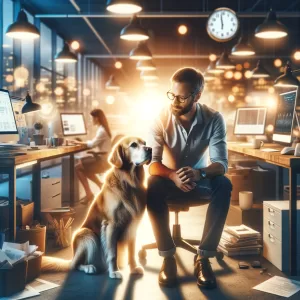There’s a silent conversation that happens between a human and a pet. This conversation transcends languages, geographical boundaries, and even time. As humans, we’ve shared a unique bond with our animal counterparts for thousands of years, a bond that has influenced our culture in ways more profound than we often realize. In this narrative journey, we’ll uncover how pets have shaped, inspired, and steered human cultures throughout history, and in turn, how they’ve sculpted the world as we know it.
Chapter 1: The Domestication Dance: An Evolutionary Waltz
It all began with the act of domestication – an evolutionary dance that saw wild animals gradually transformed into dependable companions. Through selective breeding and nurturing, humans domesticated dogs, cats, birds, and an array of other species. This process marked a paradigm shift in human-animal relationships, placing pets at the center of our survival strategy and cultural evolution.
Chapter 2: Symbols and Sacred Bonds: Pets in Ancient Civilizations
In ancient civilizations, pets held a high pedestal, often symbolizing divinity, protection, and fortune. Egyptians revered cats as sacred animals, believing they brought good luck and prosperity. In contrast, the Greeks saw dogs as loyal companions and protectors, even assigning them roles in their mythology. These cultural constructs continue to resonate in contemporary societies, influencing our perceptions and treatment of pets.
Chapter 3: Pets as Parchment: Bearing the Mark of Human Art and Literature
From prehistoric cave paintings to modern digital art, pets have been a recurring motif, reflecting our innate desire to encapsulate their essence. Pets also feature prominently in literature, both as characters and metaphors, expanding our capacity for empathy and understanding. This enduring artistic fascination underscores pets’ significant influence on human creativity and expression.
Chapter 4: Pawprints on Social Norms: Pets in Shaping Hierarchies and Customs
Pets have always played pivotal roles in shaping social norms and customs. They’ve demarcated social hierarchies, with certain species regarded as status symbols across different cultures. Customs related to pet care and management have also evolved, reflecting societal attitudes towards responsibility, compassion, and animal welfare.
Chapter 5: The Emotional Edifice: Pets as Pillars of Psychological Health
Research shows that pets have remarkable therapeutic value, providing comfort, companionship, and emotional support. They’ve come to occupy an irreplaceable space in our emotional architecture, alleviating stress and loneliness. The recognition of pets’ mental health benefits has ushered in pet therapy, enhancing our understanding of emotional wellbeing.
Chapter 6: The Digital Duet: Pets in the Age of Social Media
In the digital age, pets have catapulted to stardom, garnering millions of followers on social media platforms. This phenomenon, fueled by our desire to share pets’ innocent charm and humor, has engendered an inclusive, global community of pet enthusiasts. It has also propelled pet care innovations and highlighted the importance of animal rights.
The Unbroken Bond: Looking Back and Forging Ahead
The intricate tapestry of human culture, woven over millennia, is interlaced with vibrant threads representing our bond with pets. This bond, simultaneously timeless and evolving, continues to shape our social norms, artistic expressions, emotional landscapes, and digital discourse.
The influence of pets on human culture isn’t a chapter in our history; it’s the very book itself, being written anew with every generation. As we tread into the future, we carry this unbroken bond with us, shaping the next verses of our cultural narrative in harmony with our beloved companions. As we continue this journey, let’s remember to cherish and nurture this bond, for it’s a testament to our shared evolutionary story, a story of companionship, love, and mutual respect.








